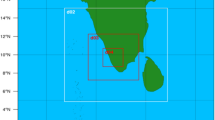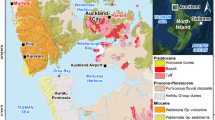Abstract
The results of instrumental studies of storm activity and parameters of lightning discharges in the south of the European part of the Russian Federation are presented. The features of spatial and temporal variations of thunderstorms and lightning parameters within a radius of 650000 km around the center of the lightning- detection network of the High-Mountain Geophysical Institute (Nalchik) covering the North Caucasus and the Black Sea coast are considered. The total number of thunderstorm days per year on the territory in question is approximately 239. The specific lightning susceptibility of the ground surface is approximately 6 discharges/km2 per year in the south and 2 discharges/km2 per year in the north. The share of terrestrial lightning discharges (positive and negative) on the territory is 12% of the total number of lightning; the share of cloud and intercloud discharges is 88%. According to these data, the share of positive discharges accounts for about 23% of the total number of the “cloud-to-ground” discharges. The average value of the electric currents is 13.5 kA in the negative lightning and 10.6 kA in the positive lightning. The parameters of lightning discharges over mountain terrain (altitude more than 1000 m) and over flatland terrain (altitude less than 1000 m) are considered separately. It has been found that the mean amplitude of the electric current of lightning discharges (regardless of polarity) amounts to approximately 9.29 kA over the flatland regions of the North Caucasus and 11.24 kA in the mountain part; the median value of the amplitude of the electric current reaches approximately 6.56 kA over the flatland terrain and 7.99 kA over the mountain terrain.
Similar content being viewed by others
References
Electric Interaction of Geospheric Shells, Ed. by V. A.Morgunov, V. A. Troitskaya, and S. V. Anisimov (OIFZ RAN, Moscow, 2000) [in Russian].
H. Volland, Atmospheric Electrodynamics (Springer, Heildelberg, 1984), pp. 128–136.
S. Despiau, “Electric field and ionic concentration variations observed at ground level in storm conditions,” Ann. Geophys. 10, 75–81 (1992).
E. R. Williams and E. A. Mareev, “Recent progress on the global electrical circuit,” Atmos. Res. 135–136, 208–227 (2014).
Guidelines on Meteorological Support for Civil Aviation (NMOGA-73) (Gidrometeoizdat, Leningrad, 1973) [in Russian].
E. M. Bazelyan and Yu. P. Raizer, Physics of Lightning and Protection Against Lightning (Fizmatlit, Moscow, 2001) [in Russian].
Guidelines for Hydrometeorological Stations and Posts, Vol. 3, Part 1: Meteorological Observations at Stations (Gidrometeoizdat, Leningrad, 1985) [in Russian].
A. I. Buz, “The probability of detection of small-scale phenomena as function of their sizes and density of the observational network,” Meteorol. Gidrol., No. 2, 63–70 (1970).
Climatic Atlas of the SSSR, Vol. 1, Ed. by F. F. Davitaya (Gidrometeoizdat, Moscow, 1960), pp. 153–154 [in Russian].
A. P. Pen’kov, “Climatic characteristics of thunderstorms on the territory of the SSSR,” Aviats. Klimatol. 34, 24–33 (1976).
Handbook of Hazardous Natural Phenomena in the Republics, Territories, and Regions of the Russian Federation, Ed. by K. Sh. Khairullin (Gidrometeoizdat, St. Petersburg, 1997) [in Russian].
T. V. Lobodin and L. V. Oguryaeva, “The duration of individual thunderstorms on the territory of the USSR,” Tr. GGO, No. 350, 74–80 (1977).
E. P. Arkhinova, “Maps of the geographical distribution of the number of days with thunderstorms on the territory of the USSR,” Tr. GGO, No. 74, 41–60 (1957).
V. P. Kolokolov, “On the characteristics of the global distribution of thunderstorm activity,” Meteorol. Gidrol., No. 11, 47–55 (1969).
I. I. Kononov, I. A. Petrenko, and V. S. Snegurov, Radiotechnical Methods for Locating Thunderstorm Sources (Gidrometeoizdat, Leningrad, 1986) [in Russian].
P. S. Lydzer, “Semiconductor thunderstorm detectors,” Tr. GGO, No. 157, 54–58 (1964).
V. D. Stepanenko and S. M. Gal’perin, Radiotechnical Methods for Thunderstorm Studies (Gidrometeoizdat, Leningrad, 1983) [in Russian].
K. L. Cummins, E. P. Krider, and M. D. Malone, “The U.S. National Lightning Detection Network and applications of cloud-to-ground lightning data by electric power utilities,” IEEE Trans. Electromagn. Compat. 40 (4), 465–480 (1998).
D. R. Poelman, W. Schulz, and C. Vergeiner, “Performance characteristics of three distinct lightning detection networks covering Belgium,” in 22nd International Lightning Conference, 2–3 April 2012, Bloomfield, Colorado, USA.
W. Schulz and M. Saba, “First results of correlated lightning video images and electric field measurements in Austria,” in 10th International Symposium on Lightning Protection (Curitiba, Brazil, 2009), pp. 503–505.
A. Kh. Adzhiev, A. V. Snegurov, V. S. Snegurov, V. N. Stasenko, and V. O. Tapaskhanov, “Thunderstorm detection systems of the Federal Service for Hydrometeorology and Environmental Monitoring on the European territory of Russia,” Abstracts of the VII All-Russian Meteorological Congress, 7–9 July 2014 (St. Petersburg, 2014), pp. 40–41 [in Russian].
A. Kh. Adzhiev, V. O. Tapaskhanov, and V. N. Stasenko, “Lightning detection system in the North Caucasus,” Russ. Meteorol. Hydrol. 38 (1), 1–5 (2013).
A. Kh. Adzhiev and E. M. Bogachenko, Thunderstorms in the North Caucasus (Poligradoservis i T, Nal’chik, 2011) [in Russian].
D. J. Boccippio, K. L. Cummins, H. J. Christian, and S. J. Goodman, “Combined satellite-and surfacebased estimation of the intracloud-cloud-to-ground lightning ratio over the continental United States,” Mon. Weather. Rev. 129, 108–122 (2001).
V. I. Kozlov, V. A. Mullayarov, Yu. M. Grigorev, and L. D. Tarabukina, “Parameters of thunderstorm activity and lightning discharges in Central Yakutia from 2009 to 2012,” Izv., Atmos. Ocean. Phys. 50 (3), 323–329 (2014).
T. V. Ershov and V. P. Gorbatenko, “Thunderstorm activity parameters from instrumental measurements,” Vesti TGPU, No. 5, 151–154 (2011).
L. N. Bol’shev and N. V. Smirnov, Tables of Mathematical Statistics (Nauka, Moscow, 1983) [in Russian].
Author information
Authors and Affiliations
Corresponding author
Additional information
Original Russian Text © A.H. Adzhiev, D.D. Kuliev, 2018, published in Izvestiya Rossiiskoi Akademii Nauk, Fizika Atmosfery i Okeana, 2018, Vol. 54, No. 4, pp. 437–445.
Rights and permissions
About this article
Cite this article
Adzhiev, A.H., Kuliev, D.D. Characteristics of Storm Activity and Parameters of Lightning Discharges in the South of the European Part of Russia. Izv. Atmos. Ocean. Phys. 54, 372–379 (2018). https://doi.org/10.1134/S0001433818040187
Received:
Accepted:
Published:
Issue Date:
DOI: https://doi.org/10.1134/S0001433818040187




